
|
|
|
|
|
|
Classic Bikes
Custom Bikes
Individual
Racing Bikes AJP
AJS
Aprilia
Ariel
Avinton / Wakan
Bajaj
Benelli
Beta
Bimota
BMW
Brough Superior
BRP Cam-Am
BSA
Buell / EBR
Bultaco
Cagiva
Campagna
CCM
CF Moto
Combat Motors
Derbi
Deus
Ducati
Excelsior
GASGAS
Ghezzi Brian
Gilera
GIMA
Harley Davidson
Hero
Highland
Honda
Horex
Husaberg
Husqvarna
Hyosung
Indian
Jawa
Kawasaki
KTM
KYMCO
Laverda
Lazareth
Magni
Maico
Mash
Matchless
Mondial
Moto Guzzi
Moto Morini
MV Agusta
MZ / MuZ
NCR
Norton
NSU
Paton
Peugeot
Piaggio
Revival Cycles
Roland Sands
Royal Enfield
Sachs
Sherco
Sunbeam
Suzuki
SWM
SYM
Triumph
TVS
Ural
Velocette
Vespa
Victory
Vincent
VOR
Voxan
Vyrus
Walt Siegl
Walz
Wrenchmonkees
Wunderlich
XTR / Radical
Yamaha
Zero
Video
Technical
Complete Manufacturer List
|
Honda CRF 1100L Africa Twin Adventure Sports ES / DCT |
| . |
|
Make Model |
Honda CRF 1100L Africa Twin Adventure Sports ES / DCT |
|
Year |
2022 |
| Engine | Four stroke, parallel Twin with 270° crank and Uni-cam, SOHC, 4 valves per cylinder |
|
Capacity |
1084 cc / 66.1 cu-in |
|
Bore x Stroke |
92.0 x 81.5 mm |
|
Compression Ratio |
10.1:1 |
| Cooling System | Liquid cooled |
|
Emission |
112g/km MT / 110g/km DCT |
| Induction | PGM-FI electronic fuel injection with 46mm throttle bodies (Throttle By Wire) |
| Ignition | Full transistorized ignition |
| Battery | 12V-6Ah Li-ion battery (20hr) |
| Starting | Electric |
|
Max Power |
75 kW / 100.5 hp @ 7500 rpm |
|
Max Torque |
105 Nm / 77.4 ft-lb @ 6250 rpm |
| Clutch | Wet, multiplate with coil springs, aluminium cam assist and slipper clutch, DCT – 2 wet multiplate clutches with coil springs |
|
Transmission |
Constant mesh 6-speed manual / 6-speed DCT with on- and off-road riding modes |
| Final Drive | 525 Chain |
| Frame | Steel semi-double cradle type with high-tensile strength steel rear sub-frame |
|
Front Suspension |
45mm cartridge-type inverted Showa telescopic fork with dial-style preload adjuster and damping adjustment w/ EERA |
|
Front Wheel Travel |
230 mm / 9.0 in |
|
Rear Suspension |
Monoblock aluminium swing arm with Pro-Link with Showa gas-charged damper, hydraulic dial-style preload adjuster and rebound damping adjustments w/ EERA |
|
Rear Wheel Travel |
220 mm / 8.6 in |
|
Front Brakes |
2x 310 mm wave floating hydraulic disc with aluminium hub and radial fit 4-piston calipers and sintered metal pads |
|
Rear Brakes |
Single 256mm wave hydraulic disc with single piston caliper and sintered metal pads. 2-Channel with rear ABS off mode |
|
ABS System |
2 channel with IMU, Selectable ABS MODE with on-road and off-road setting |
| Wheels | Wire spoke with aluminium rim |
| Front Wheel | 21M/C x MT2.15 |
| Rear Wheel | 18M/C x MT4.00 |
|
Front Tyre |
90/90-21M/C 54H (tubeless type) |
|
Rear Tyre |
150/70R18M/C 70H (tubeless type) |
| Rake | 27.5° |
| Trail | 113 mm / 4.4 in |
| Dimensions |
Length 2330 mm / 91.7 in Width 960 mm / 37.9 in Height 1490 mm / 58.6 in |
| Wheelbase | 1575 mm / 62 in |
| Seat Height | 850 mm / 33.5 in - 870 mm / 34.2 in (low seat option 825 mm / 32.5 in, high seat option 895 mm / 35.2 in) |
| Ground Clearance | 250 mm / 9.8 in |
|
Wet Weight |
238 kg / 528.7 lbs - 248 kg / 546.7 lbs DCT With Showa EERA 240kg / 529.1 lbs MT (DCT 250 kg / 551.1 lbs) |
|
Fuel Capacity |
24.8 Litres / 6.5 US gal |
| . |
From a press release issued by Honda:
Model updates: Updates for the 2022 year model of the continent-crossing ‘Adventure Sports’ version of Honda’s definitive full-sized adventurer include a shorter adjustable screen, striking new ‘Cracked Terrain’ graphics and updated DCT settings.
The fundamentals of the enduringly popular package remain: a lightweight chassis and torque-heavy 1084cc engine; a full electronics package using a six-axis Inertial Measurement Unit to manage riding modes and HSTC as well as Cornering ABS, Wheelie Control, Rear Lift Control, plus cornering detection functionality on the DCT version; standard fit cruise control, heated grips, USB port and ACC charger; a full colour 6.5-inch TFT touchscreen that incorporates Apple CarPlay®, Android Auto® and Bluetooth connectivity; dual LED headlights that feature Daytime Running Lights (DRL) technology and Cornering Lights; the option of Showa Electronically Equipped Ride Adjustment (Showa EERA™). And unmistakeable Africa Twin design and styling.
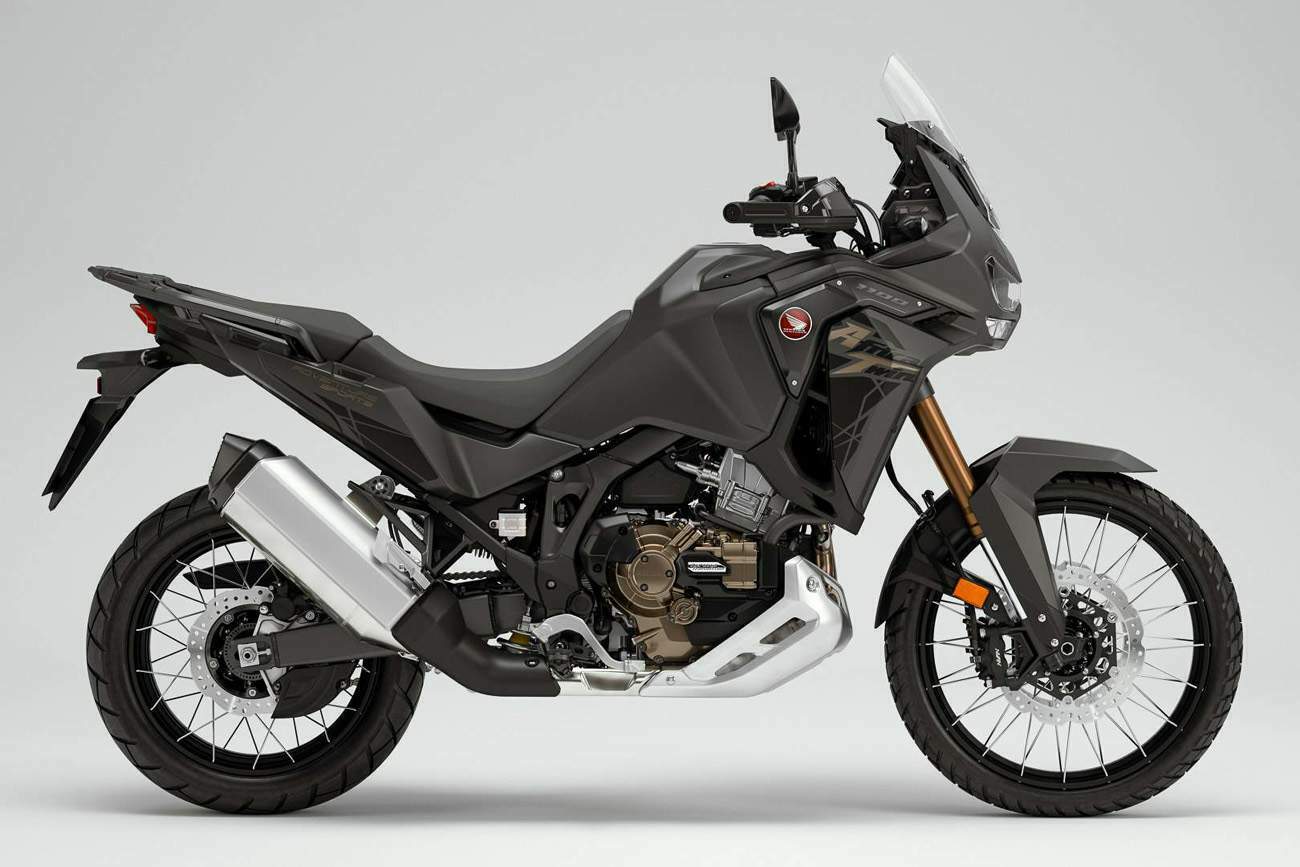
Introduction
It’s been over three decades since the Honda XRV650 Africa Twin first rolled into Europe and while the motorcycle that now bears its name – launched in 2016 as the CRF1000L Africa Twin – was a brand-new motorcycle from the wheels up, it fully inherited the essence and spirit of what made the original so popular.
It was the balance between power and weight that was at the heart of the original bike’s appeal, just as it was for the new model. With its unique, athletic appearance, an enjoyable, usable engine and capable, comfortable chassis, the CRF1000L Africa Twin proved itself a true modern-day all-rounder and has been hugely popular with round-the-world adventurers, around-town commuters and weekend tourers alike.
2018 saw the Africa Twin, in both manual transmission and Dual Clutch Transmission (DCT) form, receive Throttle By Wire (TBW) control plus 4 riding modes, expanded Honda Selectable Torque Control (HSTC) options, as well as intake and exhaust development for improved engine response and sound. The platform also expanded: the Africa Twin Adventure Sports – with the same updates but featuring improved wind protection, greater tank range and longer-travel suspension – extended the machine even further into long-range off-road territory.
For 20YM, the introduction of a bigger capacity, longer stroke 1084cc engine marked another landmark in the evolution of the Africa Twin. The CRF1100L Africa Twin* itself was comprehensively redrawn with an aggressive, compact rally style and even sharper off-road focus. Meanwhile, the touring comfort, technology and ability of the CRF1100L Africa Twin Adventure Sports were also further enhanced – including the option of the cutting-edge Showa Electronically Equipped Ride Adjustment (Showa EERA™) suspension.
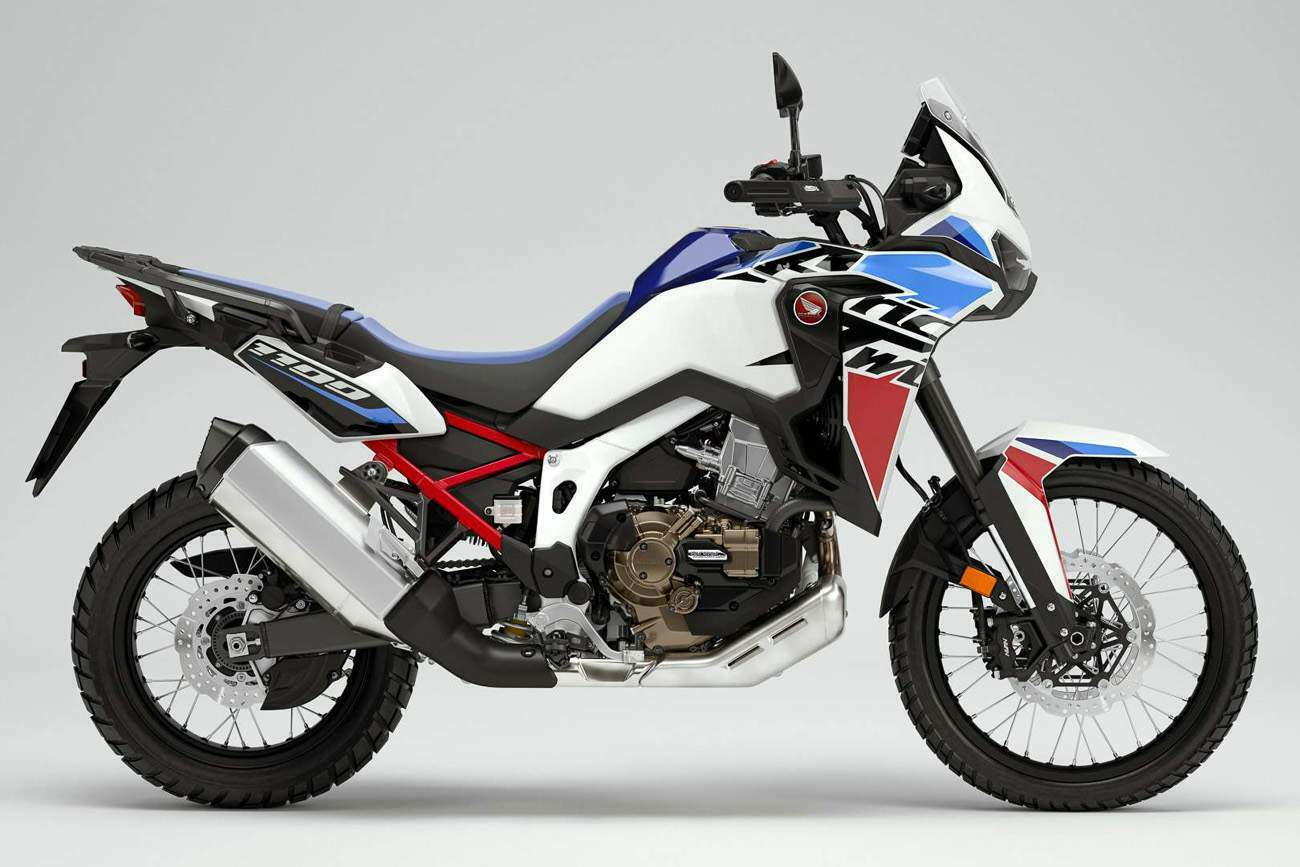
Model Overview
The CRF1100L Africa Twin Adventure Sports shares the frame, engine and riding position of the off-road focussed CRF1100L Africa Twin, but has a role very much of its own: to offer riders real continent-crossing long-haul ability and practicality both on and off-road. This comes in the shape of a large 24.8L fuel tank, extensive wind protection (from both the fairing and fairing side panels), height-adjustable screen, large engine sump guard, aluminium rear carrier plus tubeless wheels and tyres. ACC charger and heated grips are also standard fit.
The 20YM change made it smaller, slimmer, lower and 5kg lighter than the previous 998cc model, and offered stronger performance with changes to the engine that produced 7% more peak power, 6% more peak torque and much greater strength everywhere in the rev-range. It was also Honda’s first EURO5 compliant engine. The frame too was completely revised and featured a new bolt-on aluminium subframe. The aluminium swingarm was based on that of the CRF450R moto-crosser.
At the centre of the Africa Twin Adventure Sports, a six-axis Inertial Measurement Unit (IMU) controls not only the 7-level HSTC but also 3-level Wheelie Control, Cornering ABS (with off-road setting), Rear Lift Control and DCT cornering detection. There are four default riding modes: URBAN, TOUR, GRAVEL and OFF-ROAD.
For optimum suspension damping front and rear the Africa Twin Adventure Sports is also available with Showa EERA™ as an option. Four default modes – SOFT, MID, HARD and OFF-ROAD – cover every type of riding situation, and there’s a USER mode for further fine-tuning. Rear spring preload can also be adjusted while stationary.
Tailored for complete control, the riding position features a slim-section seat and high-set handlebars. Dual LED Daytime Running Lights (DRL) feature three-stage Cornering Lights – that automatically adjust the field of illumination depending on the lean angle, giving optimum visibility, improving safety. Cruise control and heated grips are standard-fit. A full colour Multi Information Display (MID) 6.5-inch TFT touch screen brings immersive engagement with the machine’s systems, plus Apple CarPlay® and Bluetooth connectivity, with Android Auto® functionality introduced in early 2021.
For 22YM, the CRF1100L Africa Twin Adventure Sport now features refined Dual Clutch Transmission (DCT) settings for even smoother handling in 1st and 2nd gears, a new shorter adjustable screen, and striking new ‘Cracked Terrain’ graphics.
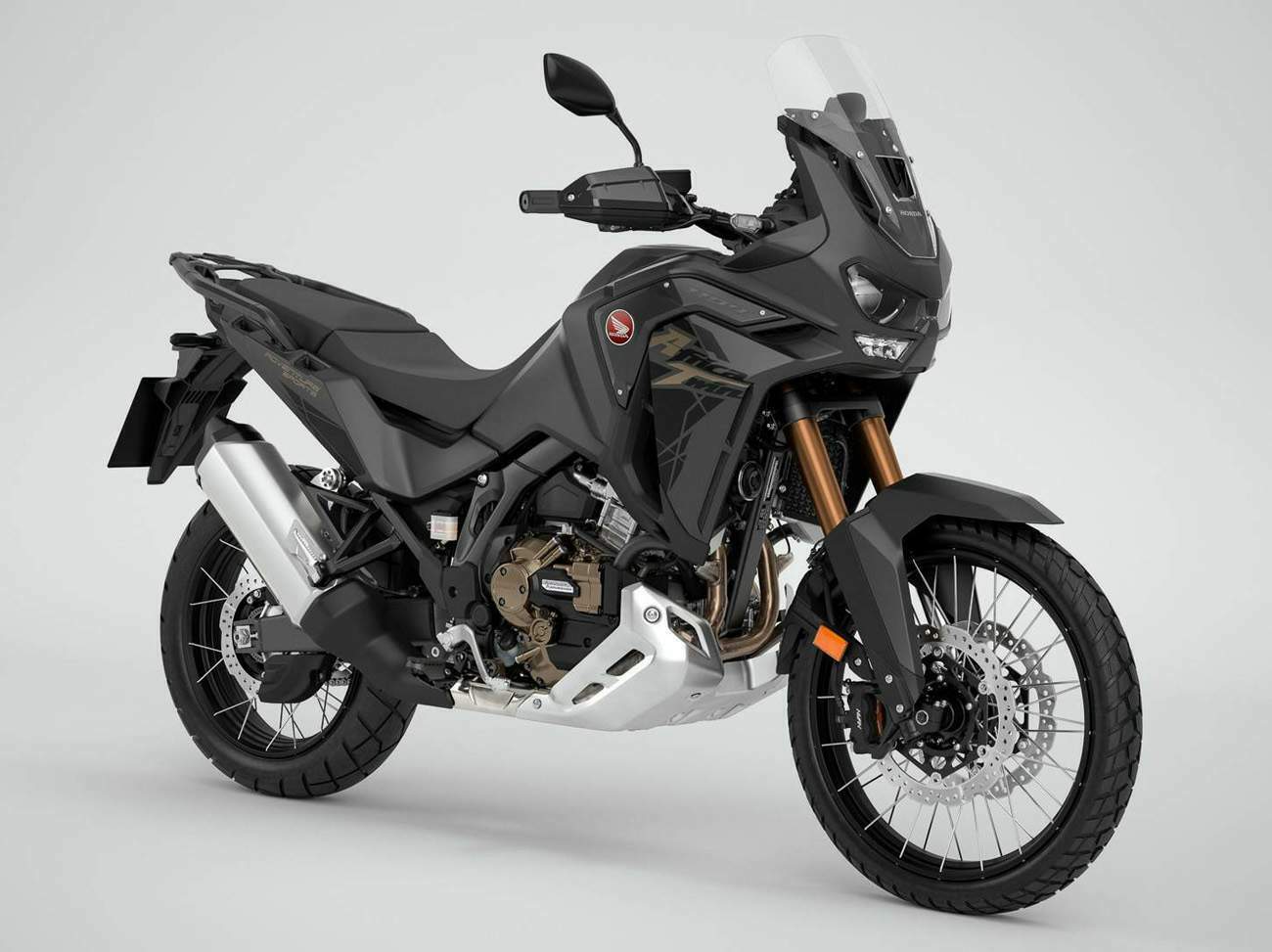
Key Features
Styling & Equipment
- Protective bodywork with a *new* shorter height-adjustable screen
- *New* ‘Cracked Terrain’ graphics
- 8L fuel tank, aluminium insert panels, rear rack and engine bash plate
- Daytime Running Lights (DRL) with Cornering Lights
- Cruise control, heated grips and ACC charger
- Multi Information Display (MID) 6.5-inch TFT touch screen
- Apple CarPlay® and Android Auto® allow use of a smartphone through the MID
Designed for the long-haul, the Africa Twin Adventure Sports has an extensive front fairing that for 22YM features a new 110mm shorter 5-level adjustable screen, improving visibility but still offering plenty of wind and weather protection. Sharing the 850-870mm seat height of the Africa Twin, the 1182mm handlebars give an upright, high-visibility riding position and comfortable control, whether standing or seated.
The tail section is extremely slim and the narrow seat is carefully contoured to allow easy back and forth movement as well as good ground reach. Holding 24.8L, the fuel tank offers a potential range of over 500km, thanks to fuel economy of 4.9L/100km (20.4km/L) MT and 4.8L/100km (20.8km/L) DCT (WMTC mode). A large engine sump guard and aluminium rear carrier are included in the specification.
Dual LED headlights are set high, delivering a penetrating beam and also feature Daytime Running Lights (DRL) that automatically adjust to ambient light intensity, improving safety, no matter the conditions. For additional security, the CRF1100L Africa Twin Adventure Sports features three-stage right/left Cornering Lights that use speed and lean angle (controlled by the IMU) to automatically adjust the area illuminated when cornering.
Large knuckle guards are standard.
The full colour Multi Information Display (MID) 6.5-inch TFT touch screen keeps the rider in control of all of the Africa Twin’s systems, with each of the riding modes selectable through the top left of the screen. The MID can also be customised to show various levels of information relative to the riding mode chosen and is easy to use even when wearing gloves.
It also incorporates Apple CarPlay® and Android Auto®, allowing use of a smartphone through the touchscreen. Navigation apps can also be accessed and displayed and via a Bluetooth helmet headset calls can be made or received. The smartphone itself plugs into a USB charging port on the right of the MID. Hands-free wireless Bluetooth connectivity is also an option and all control inputs are made from the left-hand switchgear.
The front and rear indicators have an Emergency Stop Signal function. When braking suddenly over 50kph the hazard lights flash to warn other road users a hard stop is in process. The indicators include an auto-cancel function; rather than using a simple timer, the system compares front and rear wheel speed difference and calculates when to cancel the indication relative to the situation. The auto-cancel feature can be switched off using the MID. Standard-fit cruise control eases long-distance highway travel.
The CRF1100L Africa Twin ‘Adventure Sports’ will be available in the
following colours:
Pearl Glare White Tricolour
Matte Ballistic Black Metallic
New for 2022 is the new ‘Cracked Terrain’ design and revised colour schemes which now feature new all-black aluminium side covers and aluminium rear carrier.

Engine
- 1,084cc engine gives 75kW peak power and 105Nm peak torque
- In addition to extra capacity, the 20YM updates included a new cylinder head,
valve timing and lift, throttle body and exhaust
- The variable Exhaust Control Valve (ECV) offers an engaging low-rpm sound and
high-rpm performance
- The SOHC 8-valve parallel-twin engine’s essential architecture remained
unchanged for the 20YM update, but displacement increased to 1,084cc, up from
998cc. As a result, peak power increased from 70kW to 75kW @ 7,500rpm and peak
torque from 99Nm to 105Nm @ 6,250rpm. Significantly, the obvious increase in
both power and torque made itself felt from 2,500rpm all the way through to the
redline.
To create the larger capacity, bore remained at 92mm but stroke was lengthened to 81.5mm (from 75.1mm) with a compression ratio of 10.1:1. Aluminium cylinder sleeves saved weight. Thanks to other detailed weight savings in the transmission and elsewhere, the manual transmission version of the 1084cc engine shaved 2.5kg from the previous 998cc power unit, and the DCT version 2.2kg. The cylinder head was also completely revised, and new 46mm throttle bodies introduced. The bore and cylinder pitches were aligned to create a smooth air intake profile, the ECU setting updated and injector angle modified to deliver a more direct spray into re-shaped twin-spark combustion chambers.
Other changes included optimised valve timing and increased inlet (from 9.2 to 10.1mm) and exhaust (from 8.6 to 9.3mm). To match and deal with the uprated intake efficiency and gas flow, the exhaust end-can featured a new variable Exhaust Control Valve (ECV) very similar to the unit fitted to the Fireblade. It offers enhanced engine performance and efficiency as it opens at higher rpm and gives a pleasing exhaust note ‘pulse’ at lower rpm.
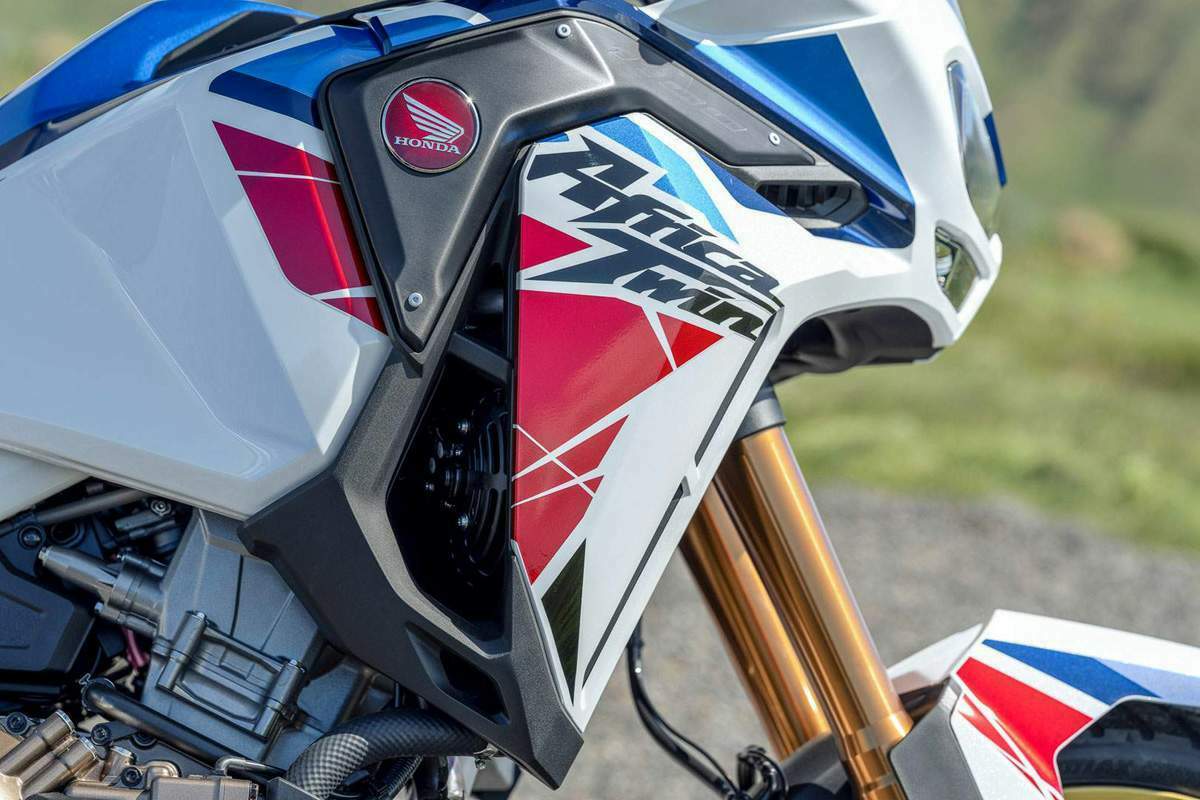
The engine’s fundamentals remained unchanged. Honda’s SOHC Unicam valve train is a feature of the MX competition-specification CRF450R and the low-set position of the cast camshaft contributes to the compact nature of the cylinder head and entire engine package.
The 270° phased crankshaft and uneven firing interval create its distinctive ‘throb’.
The crankcases are split vertically; the water pump is housed efficiently within the clutch casing with a thermostat integrated into the cylinder head. Manual and DCT versions of the engine share common crankcases with only minor external differences; the water and oil pumps are both driven by the engine’s balancer shafts.
It’s a semi-dry sump design with in-tank lower crankcase oil storage. This allows a lower pan depth that keeps overall engine height low. As the pressure-fed pump is located within the tank where it delivers its oil from, there is no need for a pressure-feed passage. Secondary vibrations are neutralised by the mutually reciprocating motion of the pistons, while primary inertial and coupling vibrations are cancelled by the use of biaxial balance shafts.
The aluminium clutch centre and pressure plate use ‘assist’ cams to ease upshifts and ‘slipper’ cams for deceleration and downshifting; for 20YM the clutch diameter was reduced in size compared to the previous design, and spring tension reduced for lighter lever feel. The six-speed manual gearbox uses the same shift-cam design as found on the CRF450R to ensure positive changes. For 22YM, improved settings for the optional Quickshifter offer even smoother changes in the lower gears.

Engine & Chassis Management Electronics
- IMU-managed HSTC intervention levels have focus on off-road use
- Wheelie Control features 3 levels and IMU management
- Four riding modes: TOUR, URBAN, GRAVEL and OFF-ROAD
- Two USER modes allow for complete riding modes customisation
- The Africa Twin Adventure Sports engine received the benefits of Throttle By
Wire (TBW) control in 2018, allowing much finer management of engine output and
character as well as expanded Honda Selectable Torque Control (HSTC) for rear
tyre grip; for 2020 the system evolved to work in conjunction with a six-axis
IMU.
The electronics system offers 4 levels of power and 3 levels of engine braking. There are seven levels of HSTC with each level’s amount of intervention being optimised to work with real-time input (yaw/roll angle and rate) from the IMU. The spacing of the levels has been optimised to allowing the rider a finer choice of the amount of rear tyre slide for off-road riding. HSTC can also be turned off completely.
Wheelie Control is another feature that was introduced in 2020. Again, with the IMU measuring pitch angle and rate, and controlling engine torque via TBW, the rider can choose between 3 levels of input. Level 1 allows for intended wheel lift but suppresses any sudden movement. Level 3 stops any front wheel elevation and level 2 is mid-way between the two. Wheelie Control can also be turned off completely.
There are four default riding mode settings: TOUR, URBAN, GRAVEL and OFF-ROAD to cover most riding conditions and situations, plus two customisable USER settings. Even within the default riding modes, it’s possible to change some parameters – HSTC between levels 1-7 (plus off), Wheelie Control between levels 1-3 (plus off) and DCT S mode shift pattern levels 1-3.
TOUR employs the highest level of Power (1), for touring loaded with pillion and luggage plus mid-range Engine Braking (2) with active on-road Cornering ABS.
URBAN suits wide-ranging riding requirements and uses mid-level Power (2) and Engine Braking (2) with active on-road Cornering ABS.
GRAVEL delivers the lowest level of Power (4) and Engine Braking (3). Cornering ABS is active with an off-road setting; in this setting, the rear brake ABS cannot be switched off.
OFF-ROAD uses lower-mid level Power (3) and the lowest amount of Engine Braking (3). Cornering ABS is active with an off-road setting; the rear brake ABS can be switched off.
USER 1 & 2 modes offer the rider a choice of two distinct personalized setups – choosing between Power levels 1-4 and Engine Braking 1-3, plus HSTC, Wheelie Control and ABS (on-road/off-road) parameters. USER 1 starts out with level 2 Power and Engine Braking, USER 2 uses level 4 Power and 3 Engine Braking.
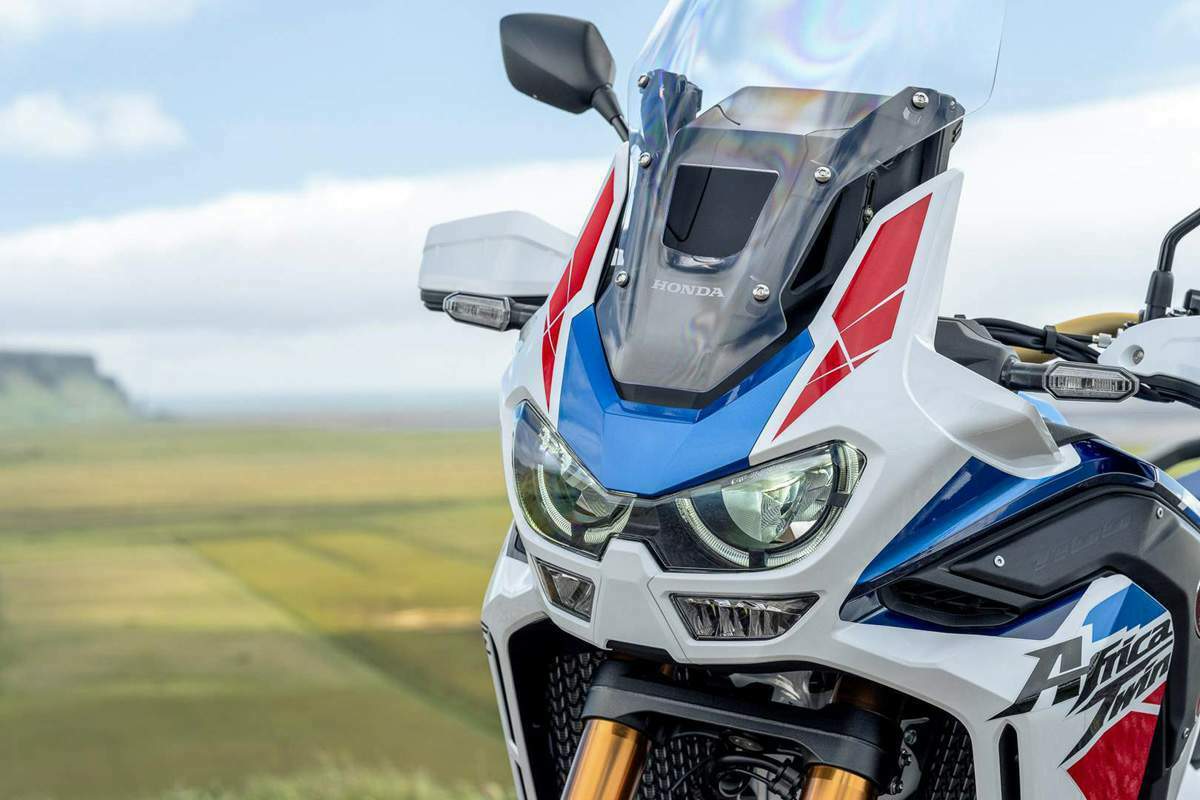
Dual Clutch Transmission
- ‘Easy and direct’ system offers super-fast gear changes in either Manual
Transmission (MT) or Automatic D and S modes
- S mode (with 3 levels) revs higher and downshifts sooner than D, for more
aggressive riding
- G switch improves rear wheel traction when off-road
- Incline detection adapts shift pattern depending on gradient
- IMU allows corning detection function for improved shift timings
- For 22YM, revised timings allow smoother handling at pull-away and in lower
gears
Honda has sold over 200,000 DCT-equipped motorcycles across Europe since the system first appeared as an option on the VFR1200F in 2009. Testament to its acceptance in the marketplace, in 2020 DCT versions of the Africa Twin (including Adventure Sports version) accounted for 47% of the model’s sales.
The unique DCT system delivers consistent, super-fast seamless gear changes, and very quickly becomes second nature in use. It uses two clutches: one for start-up and 1st, 3rd and 5th gears: the other for 2nd, 4th and 6th, with the mainshaft for each clutch located inside the other for compact packaging.
Each clutch is independently controlled by its own electro-hydraulic circuit. When a gear change occurs, the system pre-selects the target gear using the clutch not currently in use. The first clutch is then electronically disengaged as, simultaneously, the second clutch engages.
The result is a consistent, fast and seamless gear change. Furthermore, as the twin clutches transfer drive from one gear to the next with minimal interruption of the drive to the rear wheel, any gear change shock and pitching of the machine is minimised, making the change feel direct as well as smooth.
The extra benefits of durability (as the gears cannot be damaged by missing a gear), impossibility of stalling, low stress urban riding, reduced rider fatigue and greater ability to focus on cornering lines and braking points add to DCT’s appeal.
Three modes of operation are available. MT mode gives full manual control, allowing the rider to shift with the handlebar trigger control buttons. Automatic D mode is ideal for city and highway riding, and achieves optimum fuel efficiency. Automatic S mode offers three levels of sportier riding, as the ECU lets the engine rev a little higher before shifting up, and shifts down sooner when decelerating for extra engine braking.
In either D or S mode, DCT offers immediate manual intervention if required – the rider simply selects the required gear using the up and down shift triggers on the left handlebar. At an appropriate time, DCT seamlessly reverts back to automatic mode, depending on throttle angle, vehicle speed and gear position.
DCT for the Africa Twin is also fully equipped to operate in an adventure environment, with off-road functionality enhanced by the G switch accessed via the TFT touch screen display. Activating the G switch in any riding mode improves the feel for available traction and machine control by reducing the amount of clutch slip during gear changes.
Further functionality for the DCT system comes in the form of incline detection, by means of which the gear shift pattern is adapted depending on the grade of an incline to provide optimum control.
A new feature for the CRF1100L Africa Twin’s DCT system for the change to the 1084cc model for 2020 was cornering detection. When the IMU recognises the bike is cornering, the system subtly adjusts the shifting programme for the most natural gear changes.
For 2022, the DCT settings have been further optimised in first and second gears to allow smoother handling from a standing start and at very low speeds.
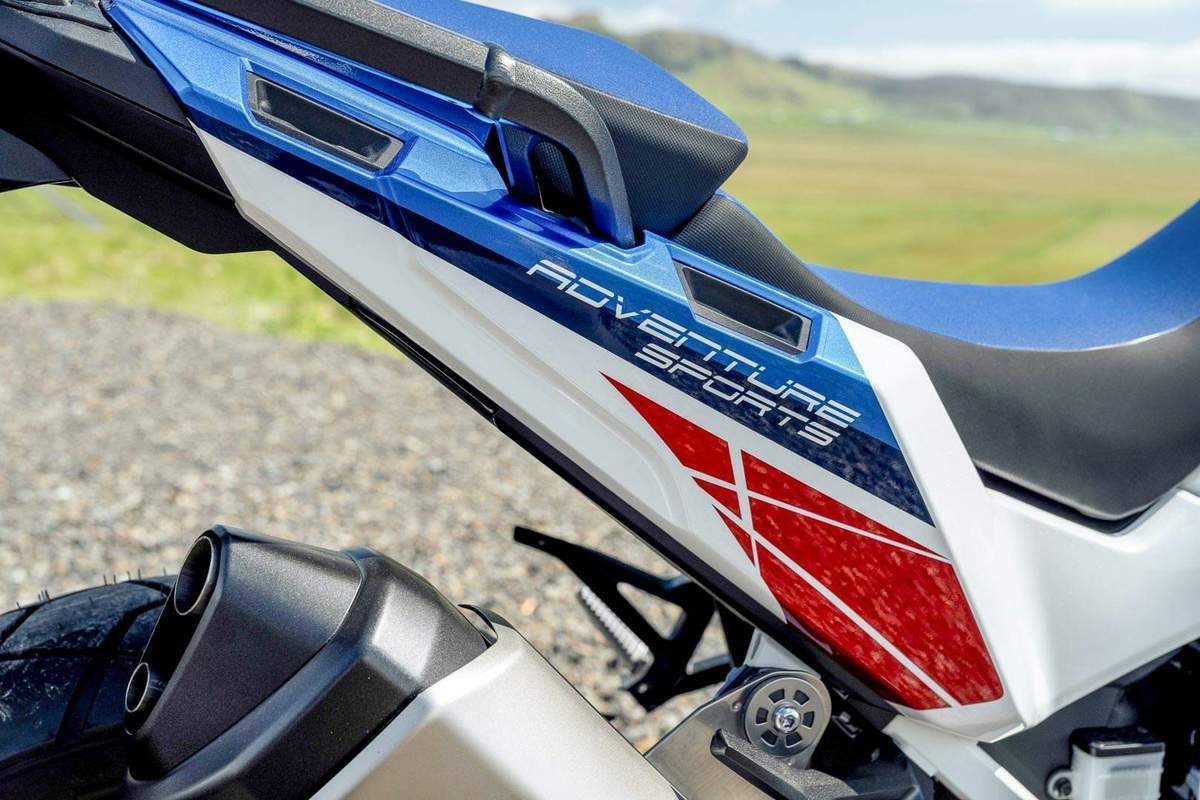
Chassis
- Light frame, with bolt-on aluminium subframe and light rigid CRF450R-style
swingarm for outstanding rear wheel traction and feel
- A six-axis Inertial Measurement Unit is housed in the centre of the machine
- Cornering ABS provides sure-footed feel and features an off-road setting
At the very heart of the Africa Twin Adventure Sports’ elevated on and off-road performance is a Bosch MM7.10 six-axis Inertial Measurement Unit (IMU) tucked away at the centre of the machine, that measures – in real-time – roll angle/rate, pitch angle/rate and yaw angle/rate. It manages rear wheel traction via TBW and HSTC, front braking grip through Cornering ABS, front wheel lift through Wheelie Control and also adds Rear Lift Control.
In conjunction with the addition of IMU control, for its 2020 evolution the strength and rigidity balance of the steel semi-double cradle frame was completely re-examined by Honda’s development engineers reinforcing its all-round on-road manners and boost off-road ability. Rigidity around the steering head was optimised to enhance feel for front end grip; the main spars were made slimmer and straighter and did away with the front cross pipe. A bolt-on aluminium subframe replaced the integral steel structure of the previous design to reduce width by 40mm to 195mm – crucial for easier ground reach. The lighter aluminium swingarm – taking its direction from the design used by the CRF450R – improved rigidity improves rear wheel traction and rider feel.
To tailor damping force front and rear – and spring preload to suit load and riding conditions – Showa Electronically Equipped Ride Adjustment™ (Showa EERA™) is an option on the Africa Twin Adventure Sports. Showa EERA™ adjusts damping force relative to riding mode selected and aims to deliver high-quality suspension reaction in diverse and opposite conditions – riding comfort at slower speeds and stability at higher speeds.
Input is gathered from stroke sensors plus Inertial Measurement Unit (IMU). There are three road settings: SOFT has the lowest damping force for smoothest reaction, versatile MID operates as an all-round setting with HARD, using the highest damping force through low-to-high stroke speed, designed for sportier riding.
There is an OFF-ROAD setting that gradually raises front fork damping force as stroke speed rises and uses higher damping settings for the rear shock.
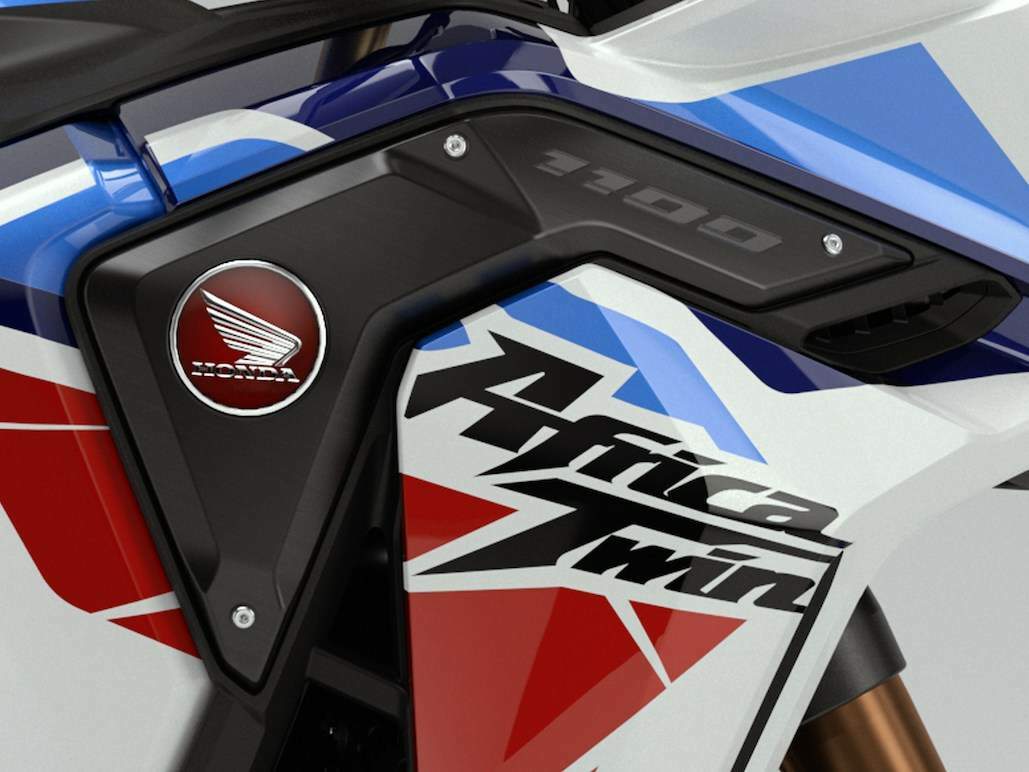
Rear spring preload can be electronically adjusted while stationary, through four default settings; 1) riding solo, 2) riding solo with luggage, 3) riding two-up and 4) riding two-up with luggage. A USER option allows for fine-tuning of damping force front and rear and 24 points of rear spring preload.
The Africa Twin Adventure Sports is also available with standard Showa suspension. With stroke length of 230mm, the 45mm cartridge-type inverted front fork offers long-travel bump absorption and features revised internal settings to improve all-round performance. Rebound and compression damping are fully adjustable. A cast aluminium top yoke and forged bottom yoke – with a hollow aluminium stem shaft – clamp the fork legs with two bolts each top and bottom.
Matching the front suspension, the Showa rear shock delivers 220mm axle travel and features a 46mm cylinder and remote reservoir for stable damping control under extreme off-road riding conditions. Spring preload can be adjusted via a dial on the shock body; rebound and compression damping are also fully adjustable.
The swingarm pivot points’ inner plates use 600MPa high-strength steel and the upper cross tube that connects them acts as the rear shock upper mount (through a pillow-ball joint) improving feel for rear wheel traction.
The IMU takes in lean angle, deceleration (from front/rear wheel speed sensors) and incorporates the slip rate of the front and rear wheels to manage braking pressure through the ABS; likewise if it detects sudden rear wheel lift, it finely controls brake force to maintain stability. When stationary the rear ABS can be cancelled for off-road riding.
Compact two-piece radial-mount four-piston calipers work dual 310mm ‘wave’ floating discs through sintered pads. The rear 256mm ‘wave’ disc features hole punching and shaping. 21/18-inch front rear (stainless steel) spoked wheels wear 90/90-21 and 150/70-18 tyres. Block pattern tyres (Continental 90/90-21M/C 54S and 150/70B 18M/C 70Q, rated at 180km/h and 160km/h respectively) are approved for fitment.
Ground clearance is 250mm, with wheelbase of 1575mm and rake and trail of 27.5°/113mm. Wet weight is 238kg, with DCT at 248kg. The Showa EERATM adds a further 2kg in both Manual and DCT guises.
To make puncture repair easier when on tour the 21/18-inch front and rear (stainless steel) spoked wheels wear tubeless Bridgestone Battlax Adventurecross Tourer AX41T or Metzeler Karoo Street tyres, sized 90/90-21M/C 54H and 150/70R18 M/C 70H. Block pattern tyres (Continental 90/90-21M/C 54S and 150/70B 18M/C 70Q are also approved for fitment).
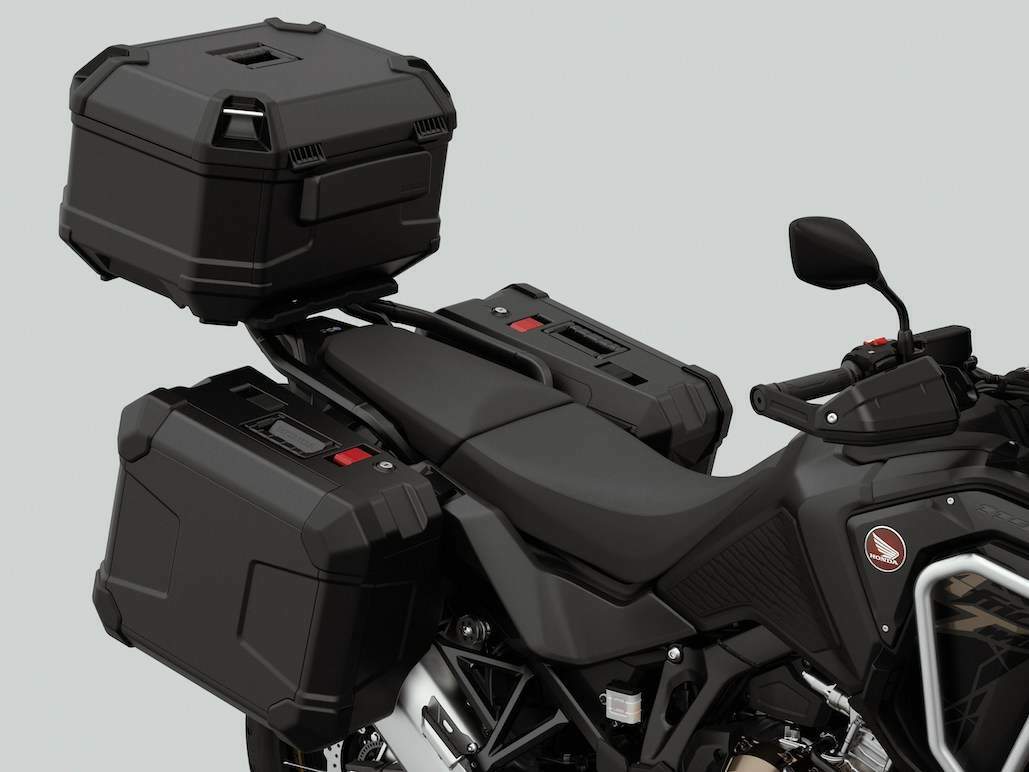
Accessories
The range of Honda Genuine Accessories for the Africa Twin Adventure Sports includes premium aluminium top box (42L) and panniers (37L left / 33L right) plus large plastic top box (58L) and panniers (40L left / 30L right), two seat heights (a lower 825-845mm and taller 870-895mm option), screen extender and deflector set, 4.5L tank bag, side tank pads, engine guards, radiator grill, side pipes and LED fog lights and centre stand.
Accessories are available in both a Super Pack and a Travel Pack for convenience.
|
Any corrections or more information on these motorcycles will be kindly appreciated. |